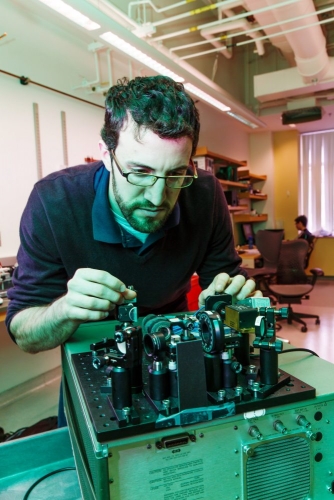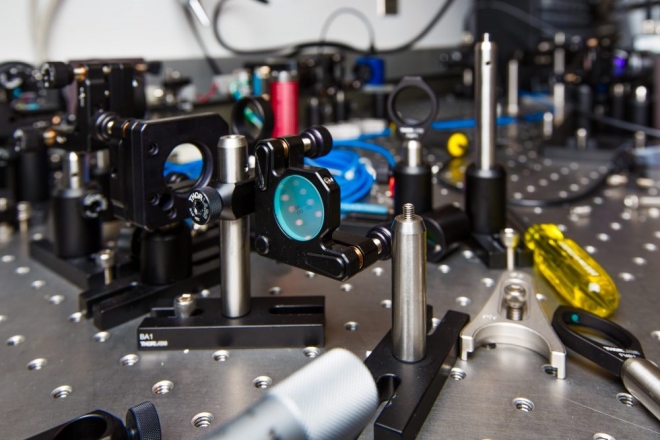July 23, 2013
By Greg Borzo
High school physics teaches that photons have no mass, but Jonathan Simon, the Neubauer Family assistant professor of physics, thinks he can make materials out of them—materials, that is, out of light.
The trick will be to ultracool the photons so they can be trapped in an optical resonator. “That will give them a physical presence, imbue them with mass and induce them to crystallize,” he said. “Metals are crystals of atoms; we want to make crystals of light.”
Traditional materials are made of atoms perturbed by defects, disorder and thermal fluctuations, Simon explained. “Our photonic materials will be simple,” he said, with no such disruptions. “One key to controlling photons with such extreme detail will be to cool them to the point that they are no longer perturbed by thermal fluctuations and can organize solely due to their interactions.”
To pull off this extreme cooling, Simon and his team of postdocs, graduate students and undergraduates are building a multimillion-dollar, one-of-a-kind machine in his ultracold quantum-materials lab. The machine will trap photons using highly reflective mirrors stabilized to the accuracy of one picometer.
Controllers on the machine will manipulate the single photons into optical lattices, like placing individual eggs into an egg carton. Simon is equipping one room of his lab with lasers, controlled by nanosecond electronics, and another with a vacuum chamber to hold the laser-cooled photons and a cloud of laser-cooled atoms to facilitate the photons’ interactions. “I’ve been doing a lot of soldering lately,” he said.
Simon calls the machine, to be completed this fall, a “particle decelerator.” While an accelerator uses high energy to tear apart atoms, this machine uses ultralow microkelvin temperatures (~273.15°C) to crystallize photons so scientists can study the bizarre laws of quantum mechanics through photonic materials. Quantum-mechanics laws often seem to defy reason and deny intuition—for example, they allow for something to exist in two places at once, at least until it is measured.
Millions of times less dense than air, the delicate photonic materials will be difficult to detect and measure. Simon “can’t wait to start playing with his machine” and hopes to see photon crystals by 2014.
This experiment combines everything the Harvard PhD and postdoctoral scholar loves about physics: optics, control of complex dynamic systems and the laws of quantum mechanics. He joined UChicago in 2012 to help build up its atomic, molecular, and optical physics programs and to study quantum materials.

Asst. Prof. Jonathan Simon describes his work as the Wild West of materials science and condensed-matter physics. Photo by Jason Smith
Simon calls himself a quantum engineer; he spends his rare free moments kite surfing and training jiujitsu. His creative side shines through in a lab he's planning for graduate and undergraduate students next winter; from balancing inverted pendula to flying autonomous drones, the course will cover technical aspects of control theory in ways both exciting and fundamentally relevant to aspiring scientists.
Simon describes his work as the Wild West of materials science and condensed-matter physics: studying how quantum mechanics imbues materials with exotic properties and how crystals form in soft vs. hard matter. “We’re certainly riding the edge of what’s possible,” he said.
In the long term, Simon’s work with ultracold quantum materials could inspire more efficient materials that harness quantum mechanics, from faster transistors that run cooler to room-temperature superconductors that transport energy across the country more efficiently.
Winner of a 2013 Department of Energy Early Career Award, a 2013 Young Investigator Award from the Air Force Office of Scientific Research, the 2012 Martin and Beate Block Award from the Aspen Center for Physics, and the 2011 AAAS Newcomb Cleveland Prize, Simon had plenty of institutions calling for his first faculty position. “I chose to come here because UChicago offers a unique blend of extraordinary scientific breadth and close collegial interaction,” he said. “Even during my interviews, would-be colleagues from across physics were finding connections between our scientific interests and challenging me to do the same. That’s how research should be done.”
—Story originally published in PSD newsletter Inquiry, spring/summer 2013















